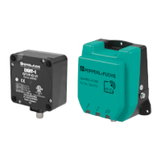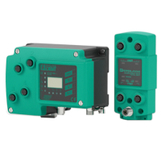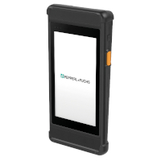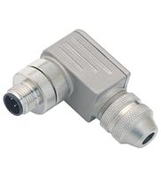RFID stands for “radio frequency identification” and refers to technologies that use radio waves to identify objects or people automatically. Typically, a serial number or other product- /object-related information (“identifier”) is stored on a microchip. This chip is attached to an antenna that enables the chip to transfer the information needed for identification to a reading device. The combination of antenna and chip is called an “RFID tag” or “RFID transponder.”
RFID readers create an energy field which activates the tags. Most common RFID tags are passive, which makes them largely maintenance-free. Depending on the type of RFID tag, a wealth of different product-related information can be stored on a single tag. Special interfaces enable the communication of the RFID system with a PLC or other IT systems.
Once an RFID system is applied in a process, error-prone manual data collection becomes a thing of the past. This means minimized administrative errors, better transparency, and huge speed gains.

Our industrial RFID tags are made for challenging environments: very high or low temperatures, excessive wear and tear, and mounting in or on metal—these RFID tags ensure that you always have the necessary data when you need it.

Each application requires a certain RFID read/write device design. Choose from our portfolio of cylindrical and cube-style housings in various sizes for LF, HF, and UHF frequency ranges. Special designed RFID read/write devices for the food or process industries complete the broad product range.

RFID control interfaces from the "IDENTControl" family represent the gateway to higher-level systems like PLC or other IT systems. They are available for all common fieldbus systems and industrial Ethernet protocols (PROFIBUS, PROFINET, EtherNet/IP, TCP/IP, MODBUS TCP/IP, EtherCAT) to offer many choices for almost every identification application. For easiest possible system integration, Pepperl+Fuchs offers ready-made function blocks. The IDENTControl system is designed in a modular way: all connected RFID readers can be operated in the same way—independent of their frequency.

RFID handhelds from Pepperl+Fuchs help you to identify RFID tags independently of stationary readers. This leads to a wide range of potential applications. Use our RFID handhelds to manually control quality or to verify maintenance work. Using a sophisticated mechanism, RFID read/write heads for different frequencies (LF, HF, UHF) can be quickly and easily attached to the handheld's base module without any tools.

With Pepperl+Fuchs, you receive all components for your RFID application from a single source. Choose from a wide portfolio of signal and bus cables, connectors, splitters, housings, mounting aids, and software to complete your individual RFID system.








 +44 161 6336431
+44 161 6336431